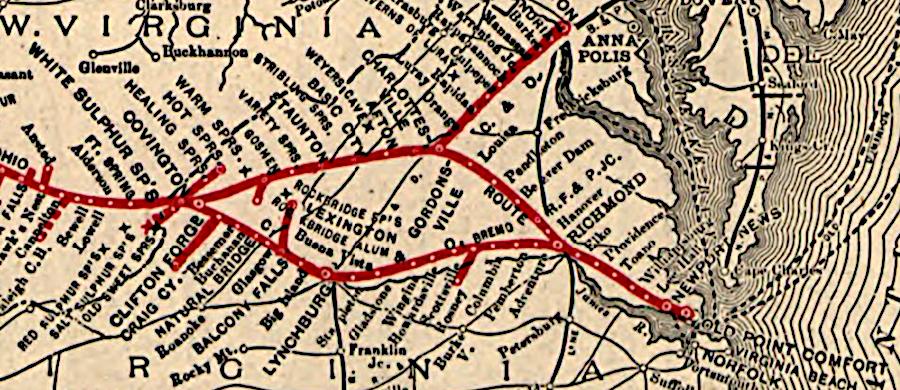
in 1895, the Chesapeake and Ohio connected the Ohio River to terminals in Alexandria and Newport News
Source: Library of Congress, Map showing the location of battle fields of Virginia (by Chesapeake and Ohio Railway Company, 1895)

in 1895, the Chesapeake and Ohio connected the Ohio River to terminals in Alexandria and Newport News
Source: Library of Congress, Map showing the location of battle fields of Virginia (by Chesapeake and Ohio Railway Company, 1895)
In 1867, the Virginia Central Railroad completed construction to Covington. In 1868, it merged with the Covington & Ohio Railroad, which had been chartered in 1853 to build from the western terminus of the Virginia Central to the Ohio River. The new company was named the Chesapeake and Ohio (C&O) Railroad.
Williams C. Wickham, a former Confederate general, was the first president. He needed to borrow money to finance the construction west from Covington, but New York bankers were reluctant to loan the capital. Williams convinced Collis P. Huntington to take the lead role, and he arranged for the financial resources needed to complete the railroad.
Huntington had been one of the Big Four investors who constructed the Union Pacific Railroad, and he envisioned the Chesapeake & Ohio Railroad as the eastern end of a transcontinental system. He became president, while Wickham accepted a significant but secondary role. Under their leadership, the railroad was extended to a new port in West Virginia on the Ohio River which Huntington named after himself.
The 428-mile Chesapeake & Ohio Railroad was built through coal fields in West Virginia. It profited from carrying coal to Richmond, where coal was loaded onto ships at the wharves downstream of Shockoe Creek at a location later called Intermediate Terminal.
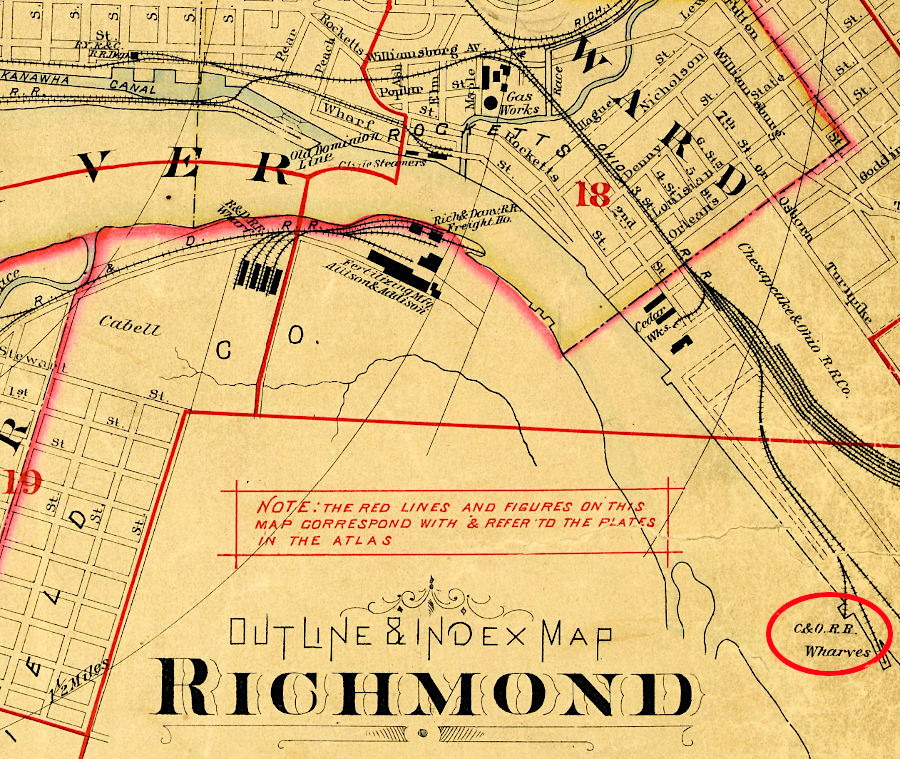
the Chesapeake & Ohio Railway shipped coal originally from West Virginia to wharves in Richmond, on the James River downstream from Rocketts Landing
Source: Virginia Commonwealth University, Baist Atlas of Richmond - Outline & index map Richmond and vicinity (1899)
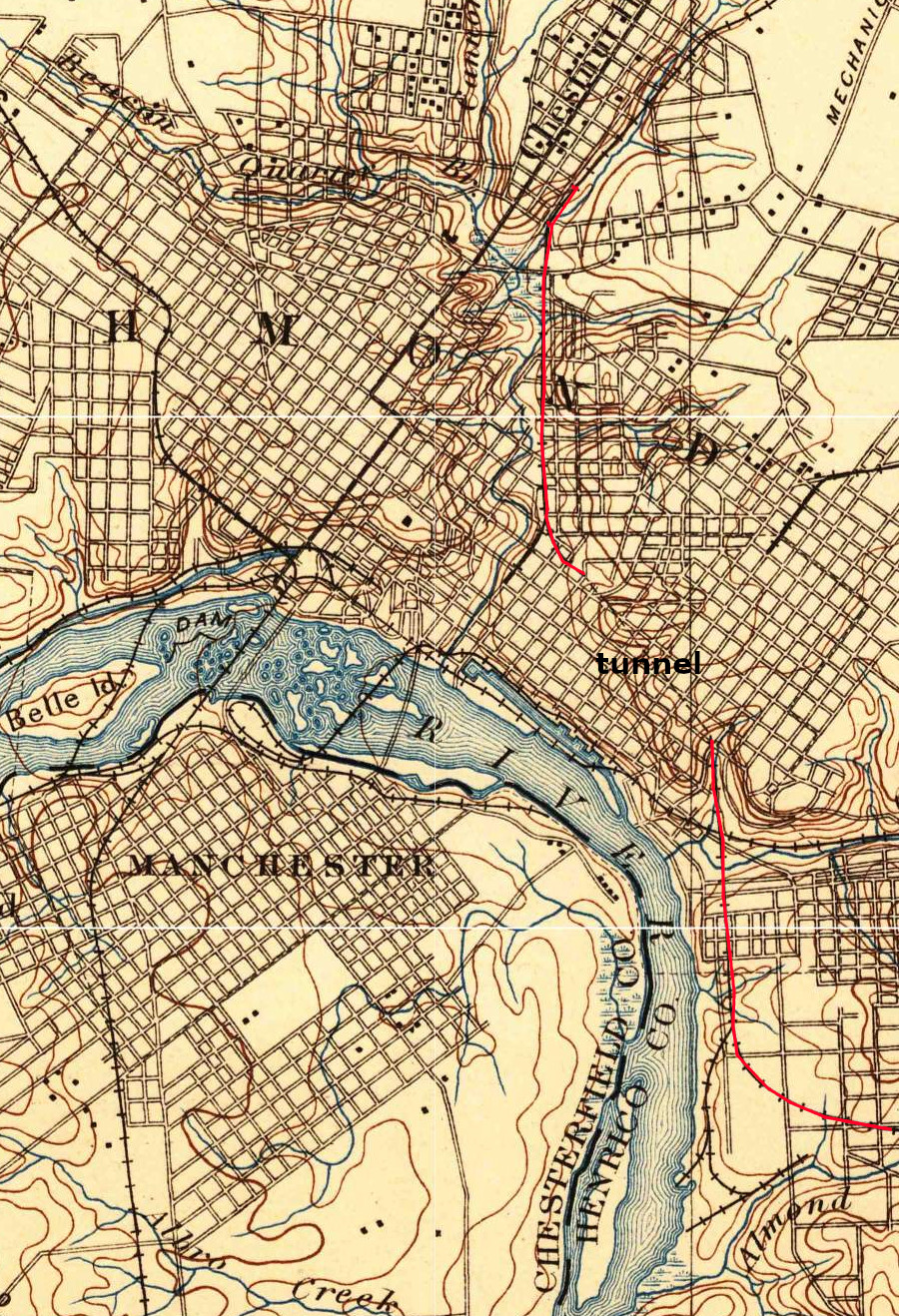
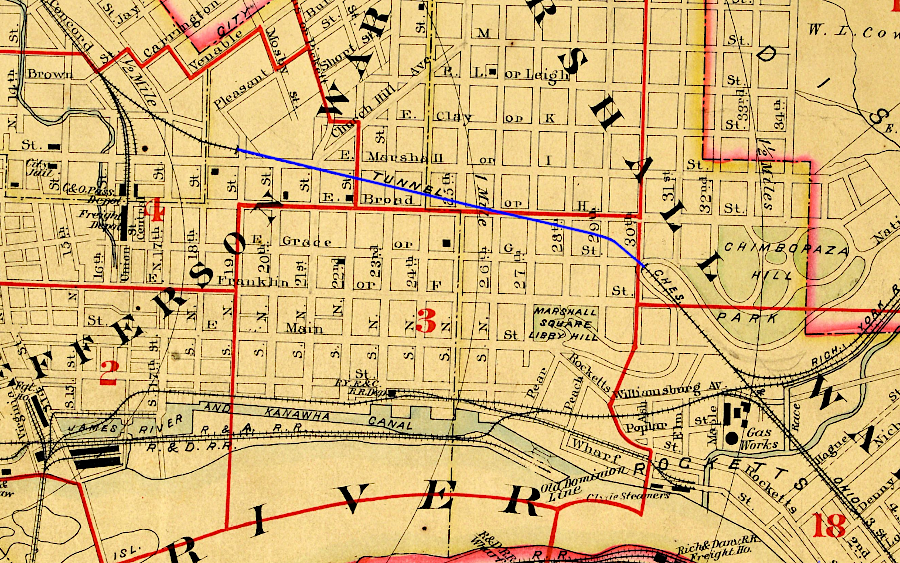
the Chesapeake & Ohio Railway built a tunnel through Church Hill to access the docks on the James River downstream of Rocketts Landing
Source: US Geological Survey, 1:62,500 Richmond VA topographic quadrangle (1895); Virginia Commonwealth University, Baist Atlas of Richmond - Outline & index map Richmond and vicinity (1899)
Huntington managed to retain control even after the railroad went into bankruptcy in 1875 and re-emerged as the Chesapeake & Ohio Railway in 1878. He expanded eastward from Richmond, down the Peninsula, to a new port on the James River which he called Newport News.1
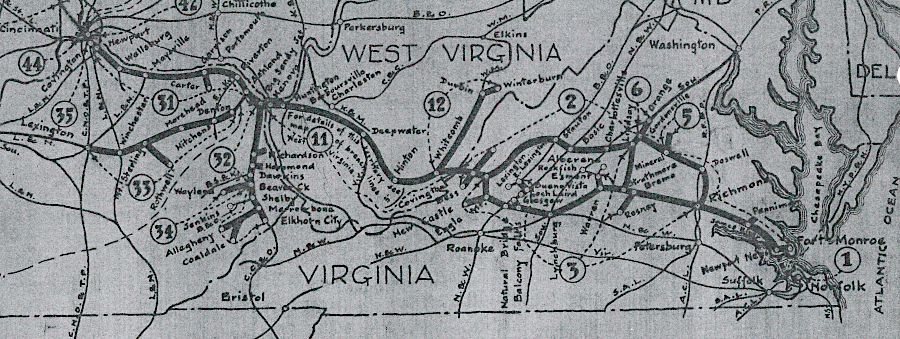
the Chesapeake & Ohio Railway built down the Peninsula to Newport News
Source: National Archives, System Index Map - Chesapeake & Ohio Railway (ca. 1915–ca. 1920)
The extension to Newport News was designed to provide a deepwater port near the Chesapeake Bay. Ships which loaded with coal at the C&O docks in Richmond had to navigate the narrow, shallow channel. Newport News offered deeper water for the larger steam-powered ships with screw propellers. Trains required more time to haul coal to the new docks over 70 miles past Richmond, but the large ocean-going steamships saved substantial time by avoiding the trip up the James River. The railroad's docks evolved into what became known as Intermediate Terminal.
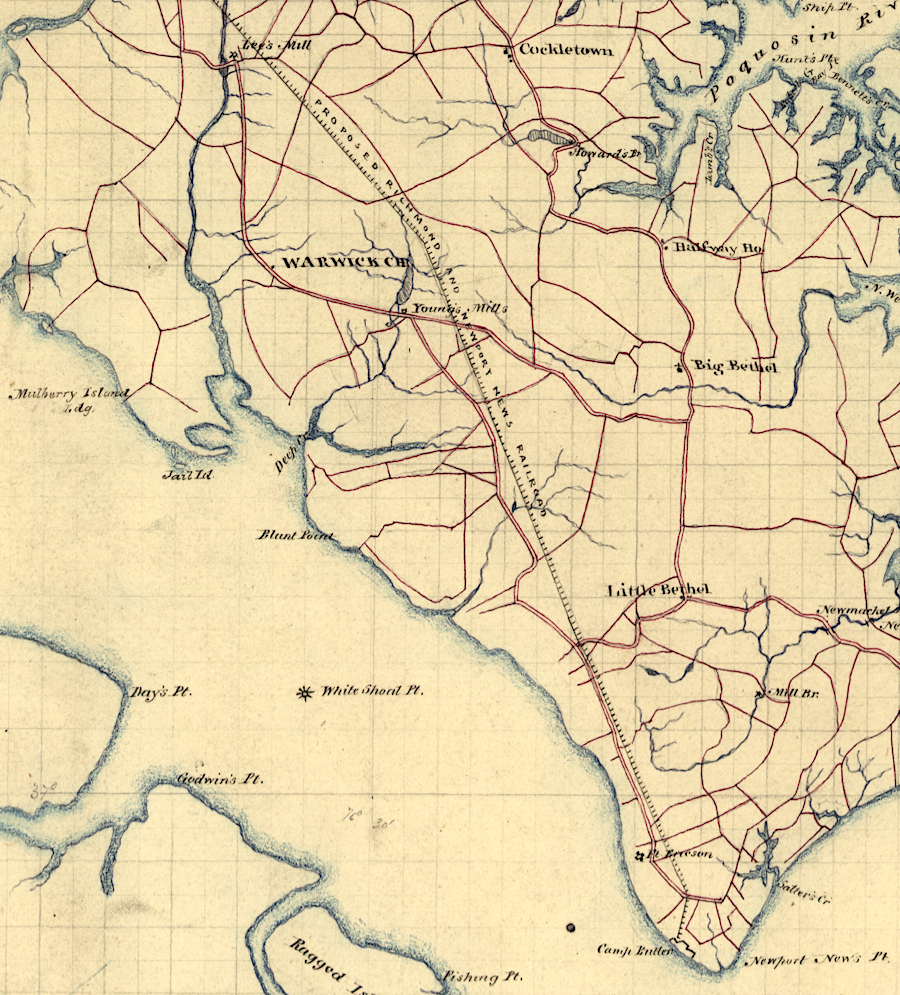
a railroad from Richmond to Newport News was proposed long before Collis P. Huntington became involved
Source: Library of Congress, James City, York, Warwick, and Elizabeth City counties, Virginia (by Jedediah Hotchkiss, 1867)

the Richmond, Fredericksburg, and Potomac Railroad stopped at Aquia Landing until 1872
Source: Library of Congress, Central Virginia (1862)
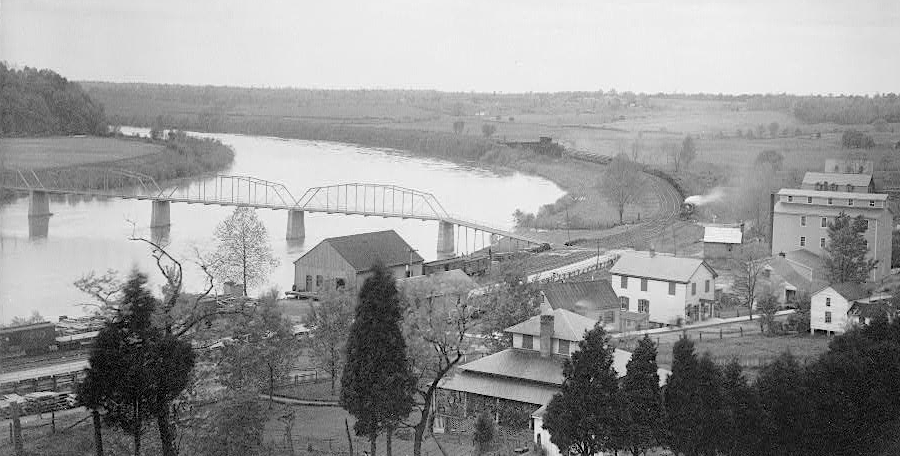
the Chesapeake and Ohio Railroad utilized the old James River and Kanawha Canal towpath, parallel to the James River, upstream of Richmond
Source: Library of Congress, View from hillside of Old Scott's Ferry, Scottsville, Virginia, showing train approaching railroad [sic] bridge
Construction and acquisition of other railroads to feed traffic into the Chesapeake & Ohio Railway required vast amounts of capital. By 1887 revenues were inadequate again to repay interest on the floating loans and bonds, and when the railroad emerged from its second bankruptcy in 1888 Huntington had lost control.
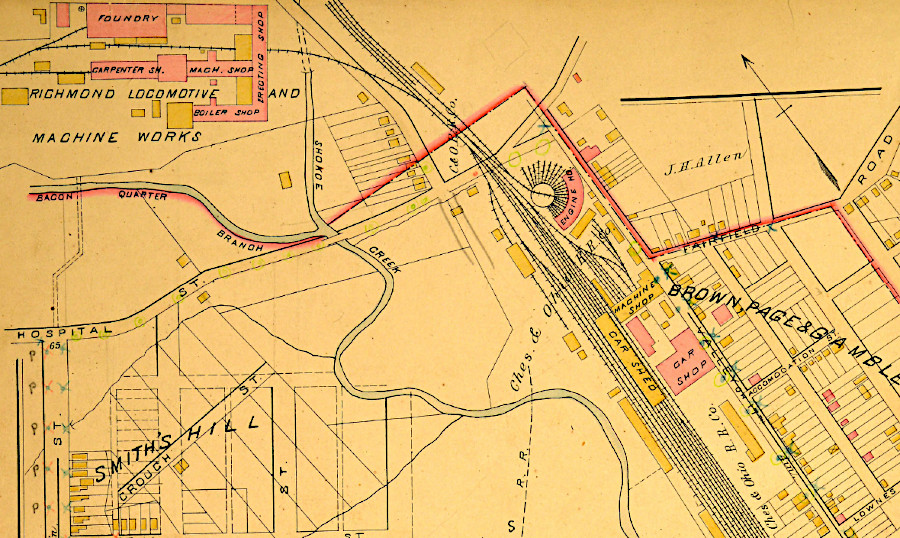
in 1889 the Chesapeake & Ohio Railway roundhouse in Richmond was in Shockoe Valley, next to the locomotive works
Source: Virginia Comonwealth University, Baist Atlas of Richmond, VA (1899)
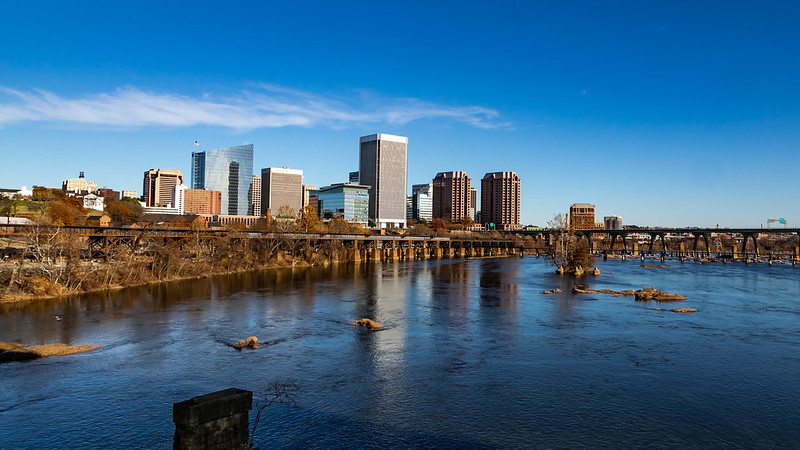
the 1901 viaduct on the James River shoreline allowed Chesapeake & Ohio trains to bypass congestion in downtown Richmond
Source: Virginia Department of Transportation (VDOT), FN3A5188 (by Tom Saunders)
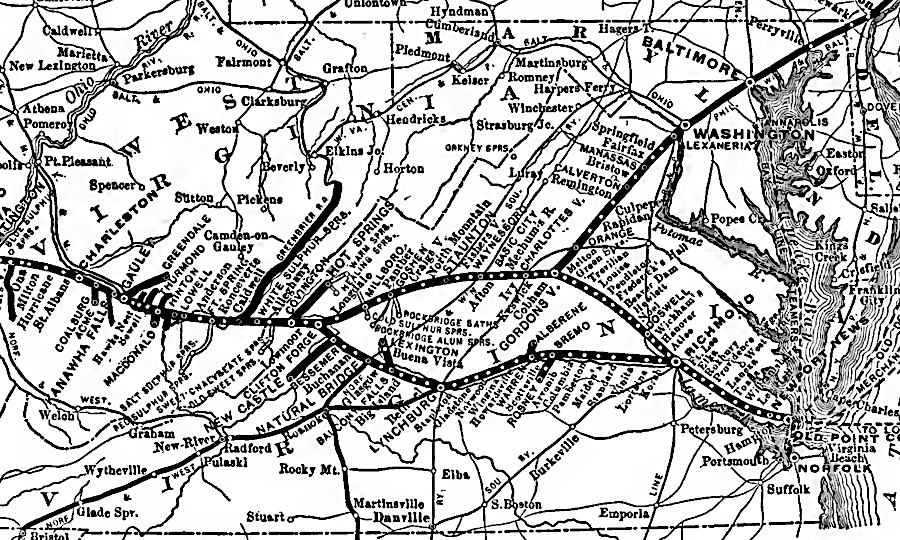
the Chesapeake & Ohio Railway in 1901
Source: Poor's Manual of Railroads (1901), Map of Chesapeake and Ohio Railway and immediate connections (p.341)
The Chesapeake & Ohio Railway and other railroads expanded their mileage in order to offer competing routes between the same destinations. The Federal government took control of the major railroads during World War I to streamline rail shipments, independent of the commercial rivalries. Plans to rationalize the overbuilt mileage railroads after the way, consolidating companies and abandoning duplicative track that was expensive to maintain, were proposed by the Interstate Commerce Commission but not adopted.
The Chesapeake and Ohio Railway stayed financially healthy during the Great Depression, due largely to continued demand for coal. It ultimately expanded to a 5,100-mile network, competing with the Norfolk and Western Railway, the Virginia Railway, and the Baltimore and Ohio Railroad to carry coal from mines in Virginia and West Virginia to the Chesapeake Bay.
Competition from truckers led to a reduction of freight shipped on the railroads, and passenger travel dried up as people chose to drive on the highways after World War II. Railroads responded by getting Interstate Commerce Commission approval to abandon stretches of track where operations and maintenance costs exceeded revenues. Pulling up the rails also reduced property taxes.
Consolidation with parallel lines was another technique to reduce costs and maintain profitability. The Norfolk and Western Railway and the Chesapeake and Ohio Railway each sought to purchase the Virginian Railway in the 1950's, and ultimately the Norfolk and Western won that battle. Efforts by the New York Central to purchase the C&O were rejected; instead, the Chesapeake and Ohio Railway acquired control of the Baltimore and Ohio (B&O) Railroad in 1962. The B&O already owned a large part of the Western Maryland Railway.
The Norfolk and Western, New York Central, and Pennsylvania railroads all had concerns about a unified C&O-B&O system, but did not object to the merger while they all had proposals before the Interstate Commerce Commission. The Norfolk and Western Railway was proposing at the time to acquire the New York, Chicago & St. Louis (Nickel Plate) and the Wabash railroads. The Interstate Commerce Commission also was considering a proposal of the New York Central (NYC) and Pennsylvania Railroad (PRR) to merge into the Penn Central.
A commissioner, who voted against the mergers by which the Norfolk and Western and the Chesapeake and Ohio expanded their networks, noted that the major railroads made a conscious choice not to introduce evidence that might block any of the desired consolidations. Instead, they engaged in a "reciprocity of silence." The 1962 decision to approve the Chesapeake and Ohio Railway's acquisition of the Baltimore and Ohio Railway determined how consolidation of other railroads would evolve in the 1960's, though there were additional proposals which were not implemented.2
After the Norfolk and Western Railway absorbed the Nickle Plate and Wabash railroads in 1964, the already-expanded Chesapeake and Ohio Railway and the Norfolk and Western Railway proposed to merge in 1965. A report to the US Senate later noted:3
The Penn Central was created in 1968, and it went bankrupt in 1970. The projected savings from streamlined operations and reduction of duplicative infrastructure failed to materialize. The corporate cultures were not aligned, and post-merger operations were disrupted rather than improved. The railroads had separate computer and billing systems, and attempts to realign how freight was routed resulted in lowered efficiency as rail cars were lost in classification yards.
The Interstate Commerce Commission initially was prepared to approve the merger of the Norfolk and Western Railway and the Chesapeake and Ohio Railway. As the newly-created Penn Central's operational problems became obvious, the merger plans were dropped.4
The Chesapeake and Ohio Railway purchase full control of the Western Maryland Railway in 1967, but did not initially try to change operations substantially. The C&O, B&O, and Western Maryland Railroad formed the Chessie System in 1973 as an intermediate step prior to consolidating how trains were managed.
In 1980, the Chessie System and the Seaboard Coast Line created CSX Corporation. The Chesapeake and Ohio Railway remained an independent corporation until August 31, 1987, when it was folded into CSX Transportation.5
Chesapeake and Ohio Railway heritage is still preserved in various places, but over time may be diminished. In Richmond, the Westham station built in 1911 was moved to the "Travelland" park next to I-64 and reopened in 1964. The building became the city's information center in 1975. After that center moved downtown in 2002, city officials let the building decay.
In 2025, a local historian articulated the reasons why preserving an old railroad structure, once heated by just a coal-fired stove, was justified:5
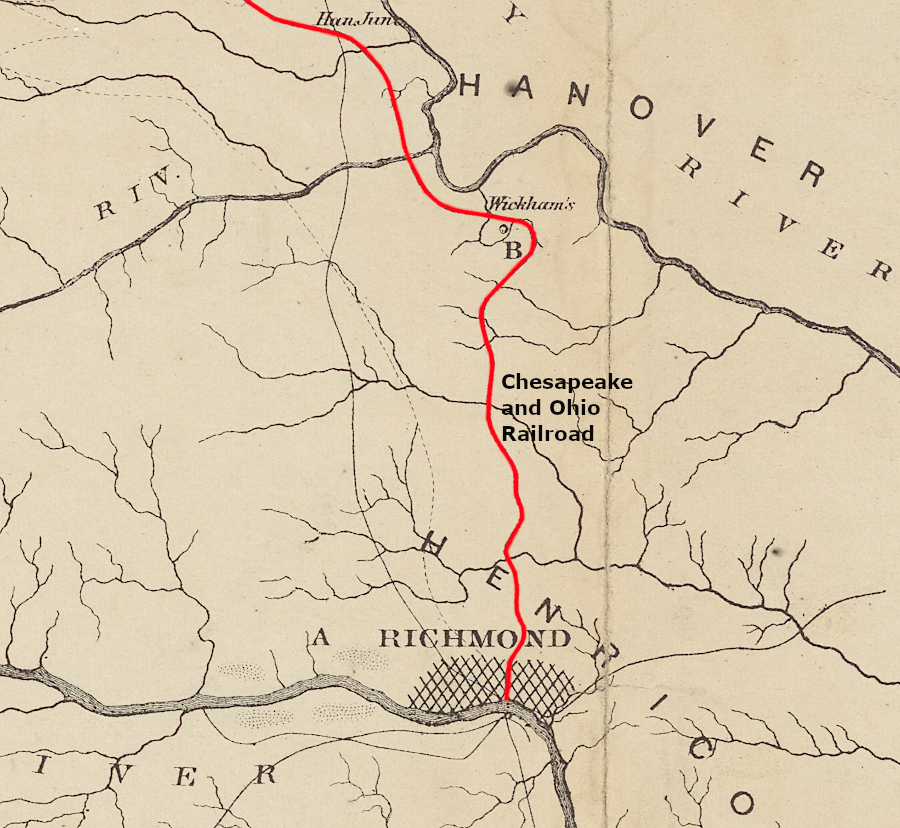
in 1872, the eastern end of the Chesapeake and Ohio (C&O) Railroad was at the James River docks in Richmond
Source: New York Public Library, Map showing the economic minerals along the route of the Chesapeake & Ohio Rail Way (1872)
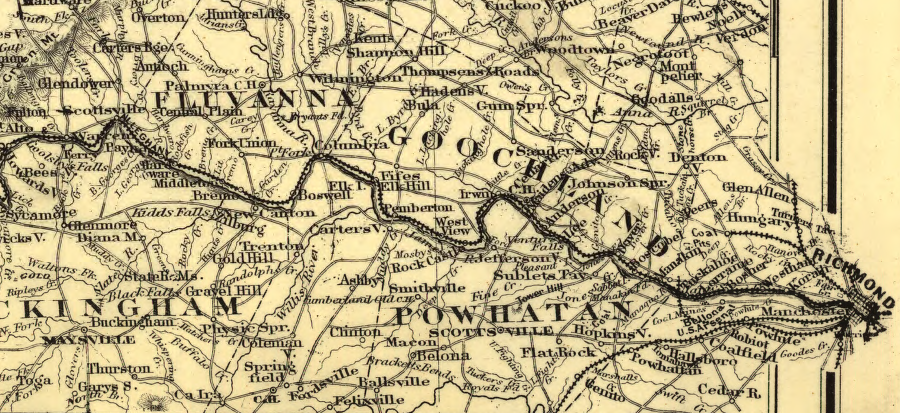
the Chesapeake and Ohio purchased the Richmond and Allegheny Railroad, which was built on the old James River and Kanawha Canal towpath
Source: Library of Congress, Map showing the West Virginia Midland Railway and its connections (G.W. & C.B. Colton & Co, 1883)
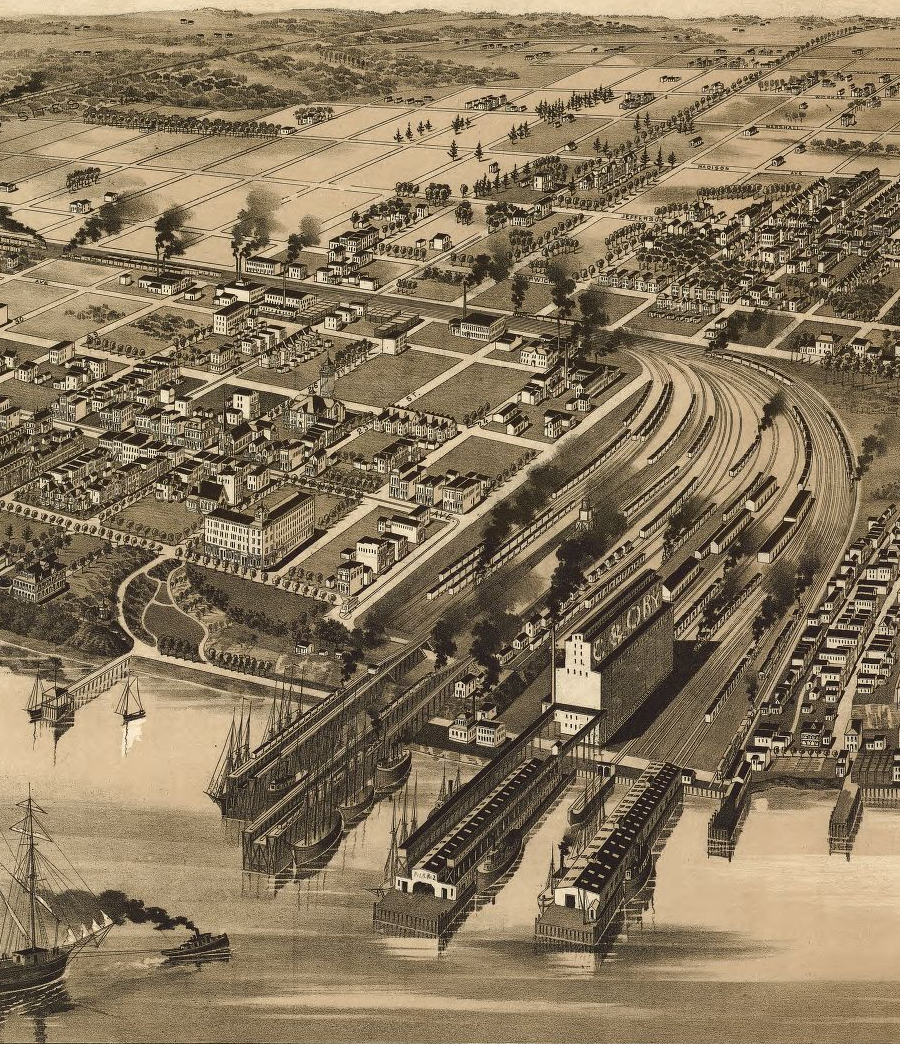
the Chesapeake and Ohio Railroad built coal export docks in Warwick County, creating the town (later city) of Newport News
Source: Library of Congress, Perspective map of Newport News, Va., county seat of Warwick County 1891
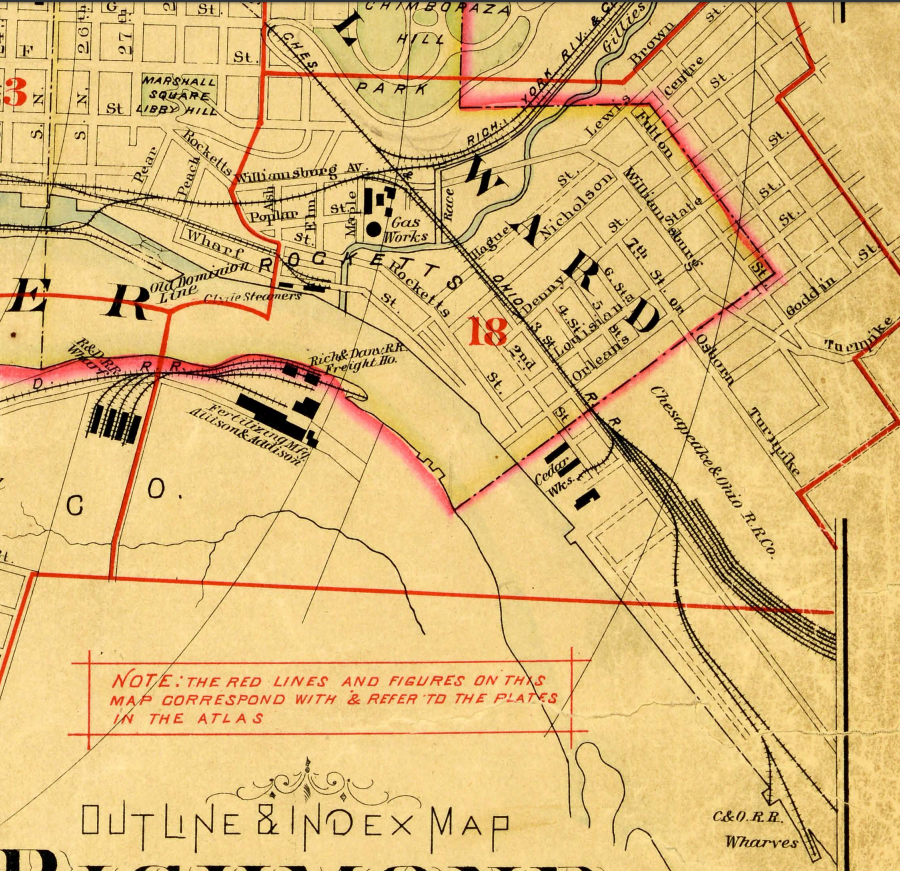
the Chesapeake and Ohio Railroad completed a tunnel through Church Hill in 1873 to access docks on the James River
Source: Virginia Commonwealth University, Atlas of the City of Richmond (George William Baist, 1889)
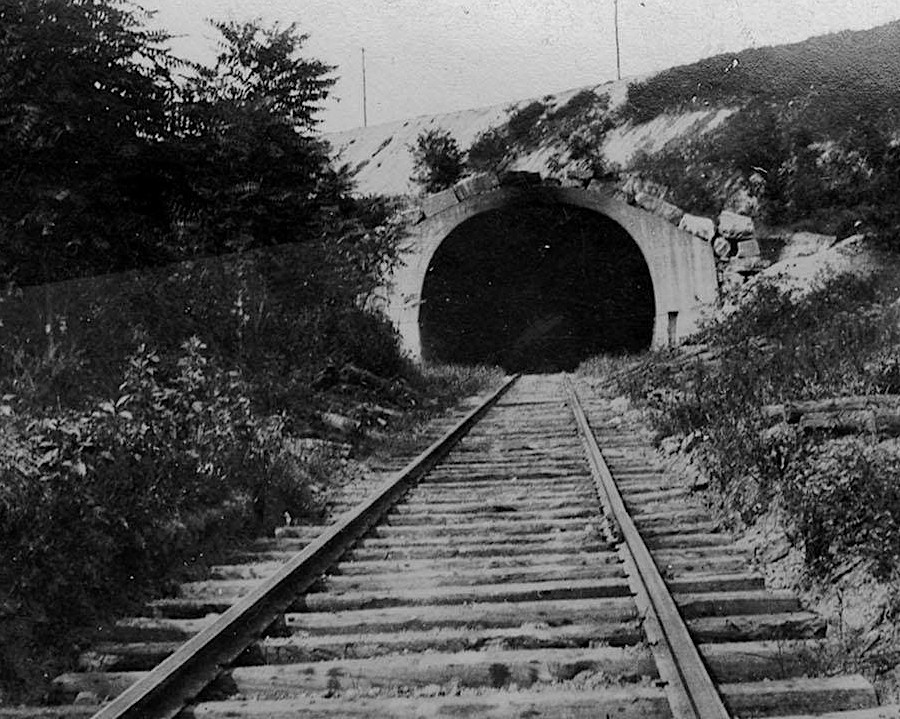
the Chesapeake and Ohio Railroad tunnel underneath Church Hill
Source: Virginia Commonwealth University, Church Hill Tunnel
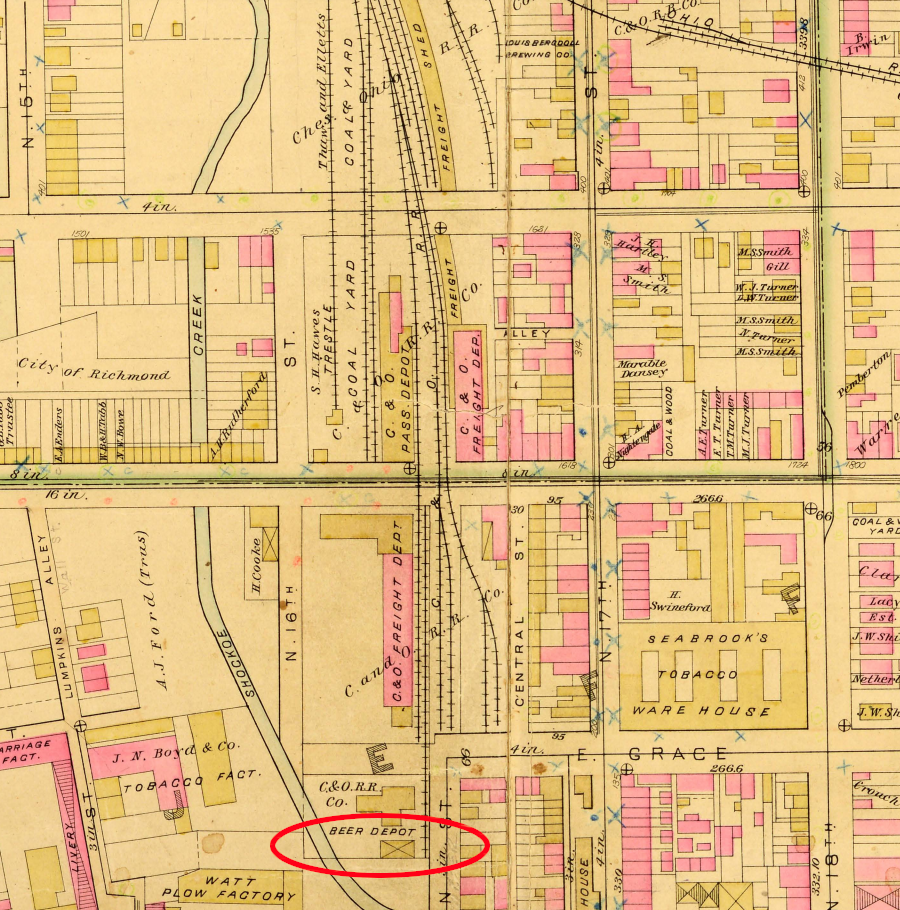
the Chesapeake and Ohio Railroad track in Richmond ended at the beer depot in 1889
Source: Virginia Commonwealth University, Baist Atlas of Richmond - Outline & index map Richmond and vicinity (1899)
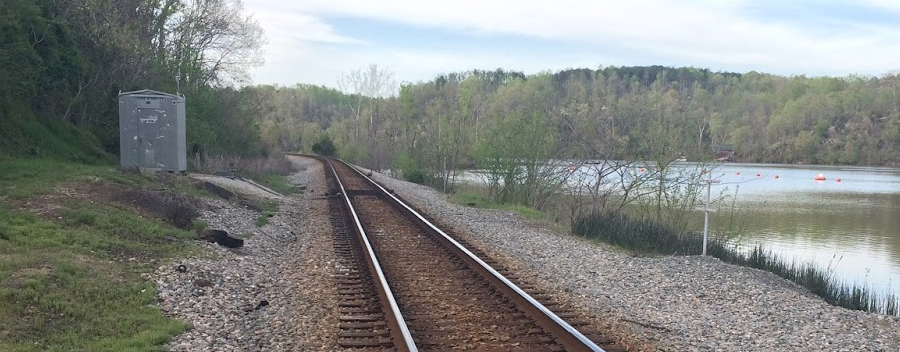
the C&O line still operates today as the CSX, upstream of Lynchburg
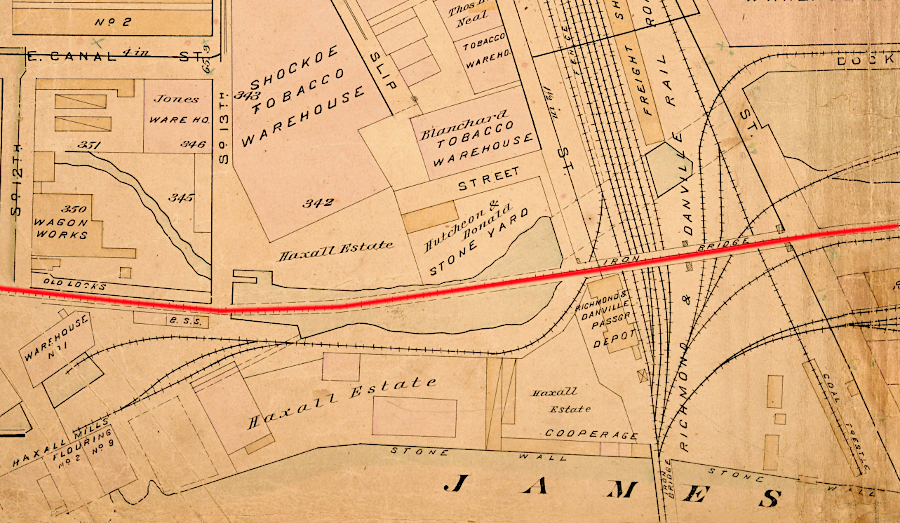
the Richmond and Alleghany Railroad tracks along the Richmond waterfront were replaced by a viaduct in 1902
Source: Virginia Commonwealth University, Baist Atlas of Richmond - Outline & index map Richmond and vicinity (1899)
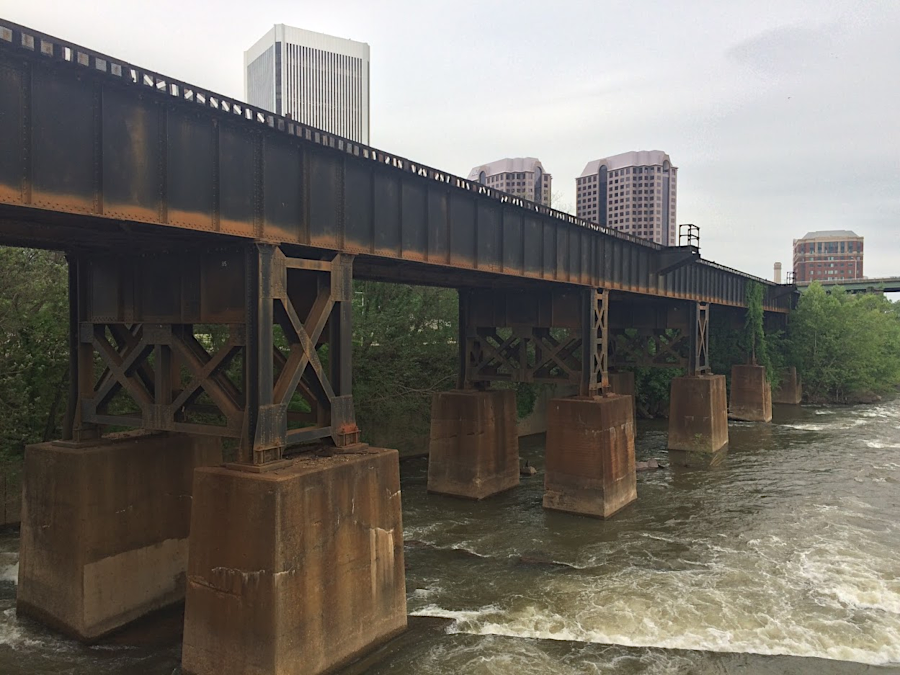
Chesapeake and Ohio Railroad viaduct in Richmond, along the James River shoreline
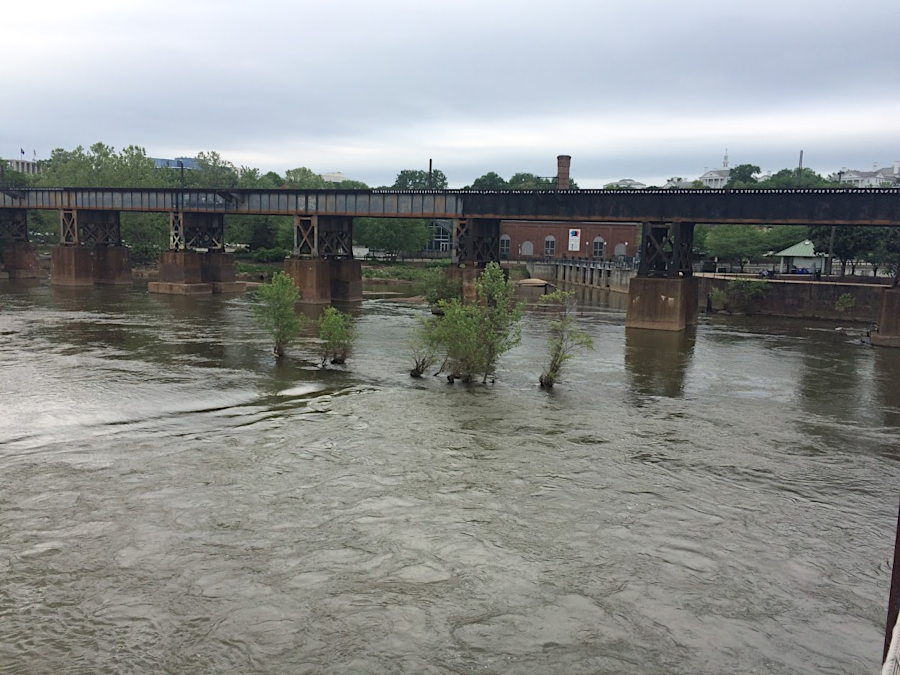
Chesapeake and Ohio Railroad viaduct in Richmond, seen from the "T. Pot" Bridge
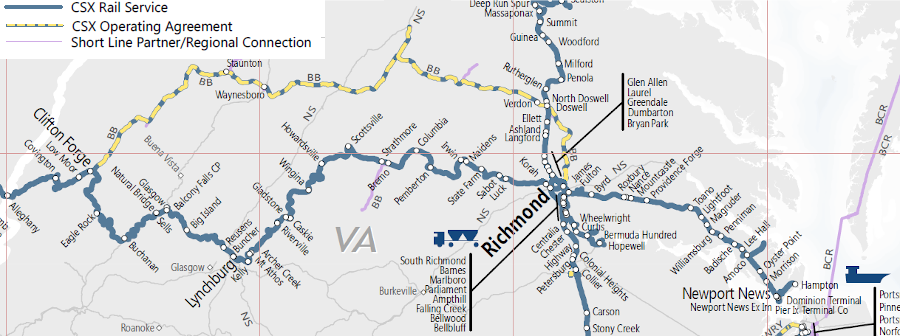
the CSX still has the ability to serve all of the original Chesapeake and Ohio (C&O) Railroad stations
Source: CSX, CSX System Map
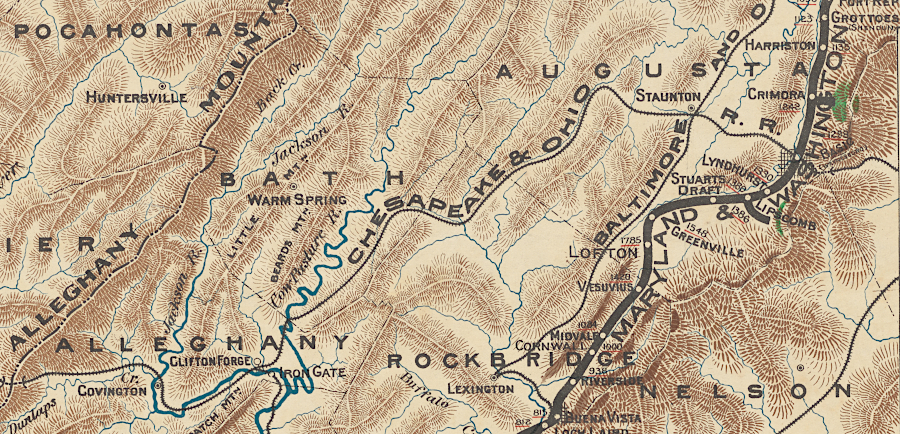
the Chesapeake and Ohio (C&O) Railroad west of Staunton in 1890
Source: New York Public Library, Mineral territory tributary to Norfolk and Western Railroad (1890)
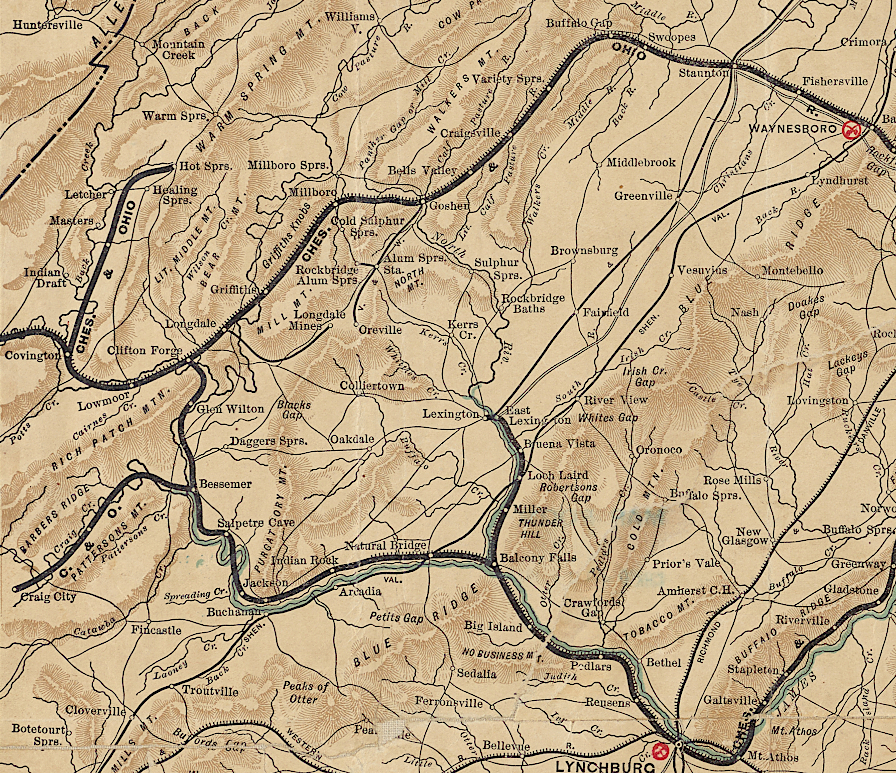
Chesapeake and Ohio (C&O) Railroad in western Virginia in 1891
Source: New York Public Library, Map showing the location of battle fields of Virginia (1891)
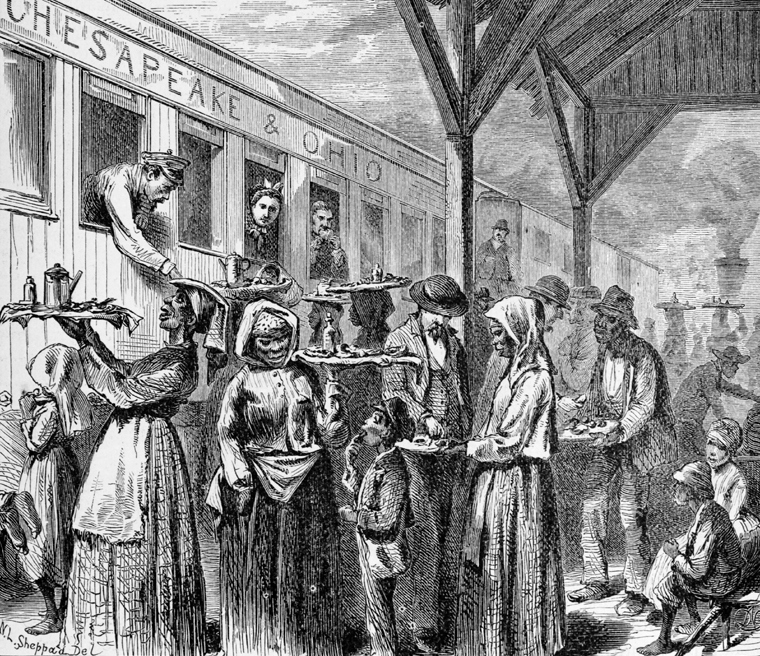
Gordonsville residents sold food to passengers when Chesapeake and Ohio (C&O) Railroad trains stopped in town
Source: New York Public Library, Gordonsville, Virginia (by Edward King, 1874)
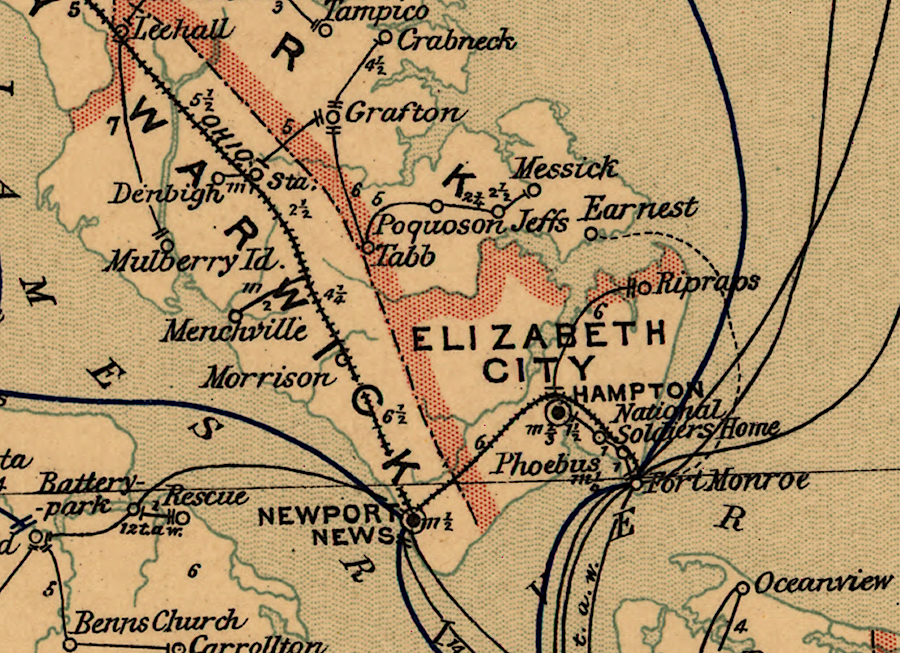
the Chesapeake and Ohio Railroad built track to Old Point Comfort (Fort Monroe)
Source: Library of Congress, Post route map of the state of Virginia and West Virginia (1896)
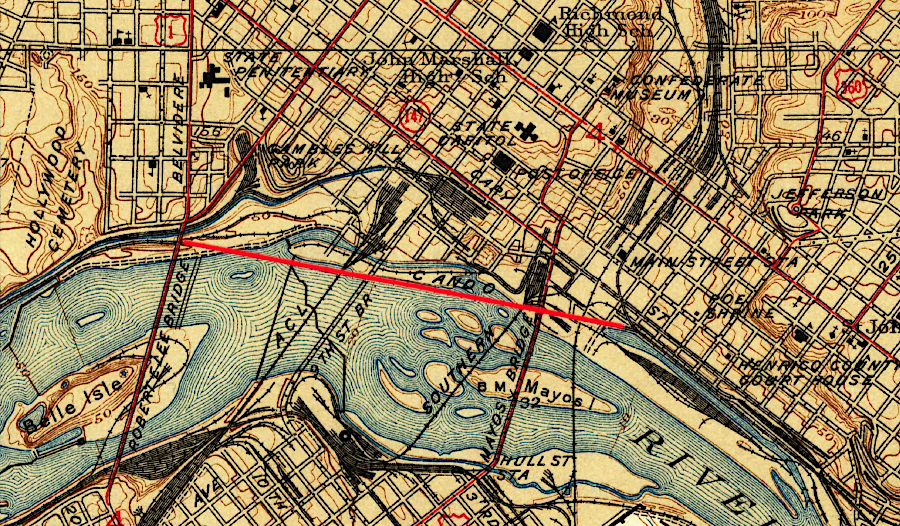
the Chesapeake and Ohio Railroad viaduct (red) bypassed congestion along the Richmond waterfront
Source: US Geological Survey (USGS), Richmond, VA 1:31,680 topographic quadrangle (1939)
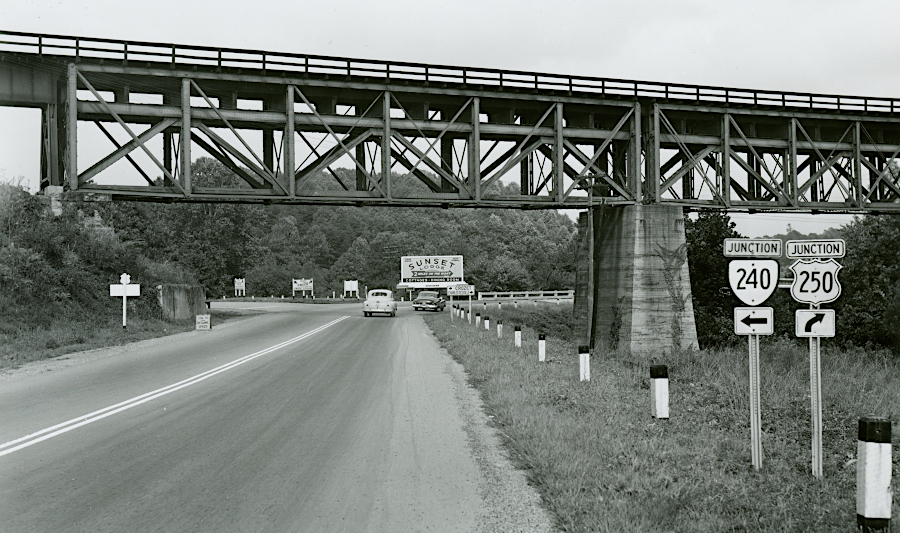
C&O bridge at Mechums River west of Charlottesville in 1951
Source: National Archives, Signs at Junction of State Route 240 and U.S. Route 250
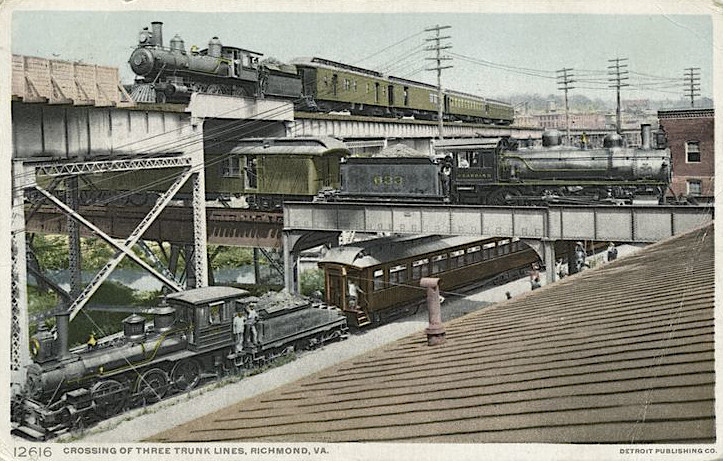
the Chesapeake and Ohio (C&O) Railroad viaduct on the Richmond waterfront was the top level of Richmond's unique Triple Crossing (as seen in a postcard painting)
Source: New York Public Library, Crossing of Three Trunk Lines, Richmond, Va.
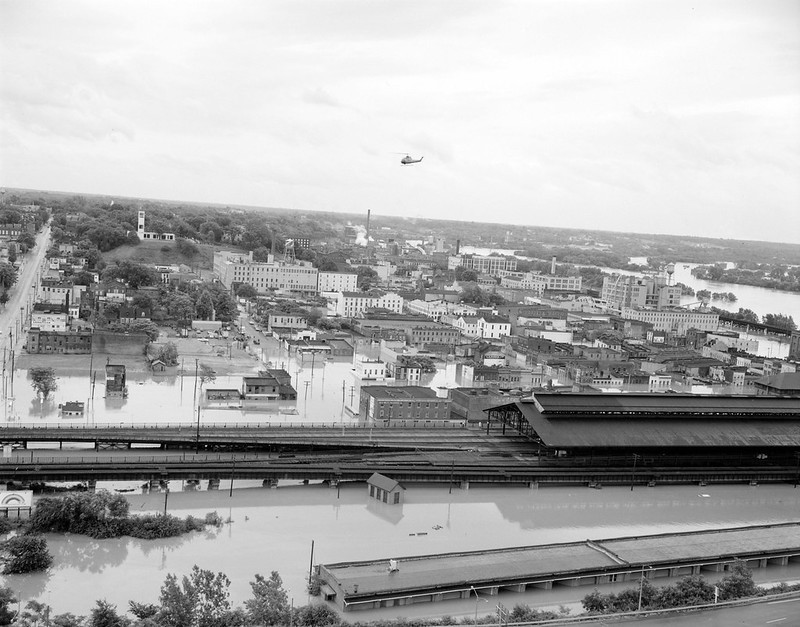
flooding from Hurricane Agnes in 1972 forced Main Street Station to close
Source: Library of Virginia, Eastern View in Richmond
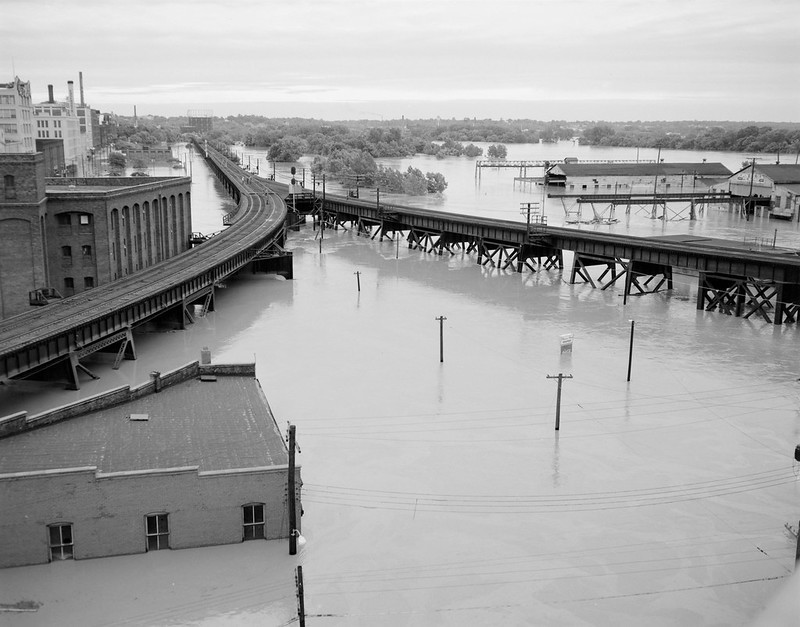
the Chesapeake and Ohio Railway and viaduct, looking east from I-95 past Main Street Station during Hurricane Agnes flooding in 1972
Source: Library of Virginia, James River Flooding
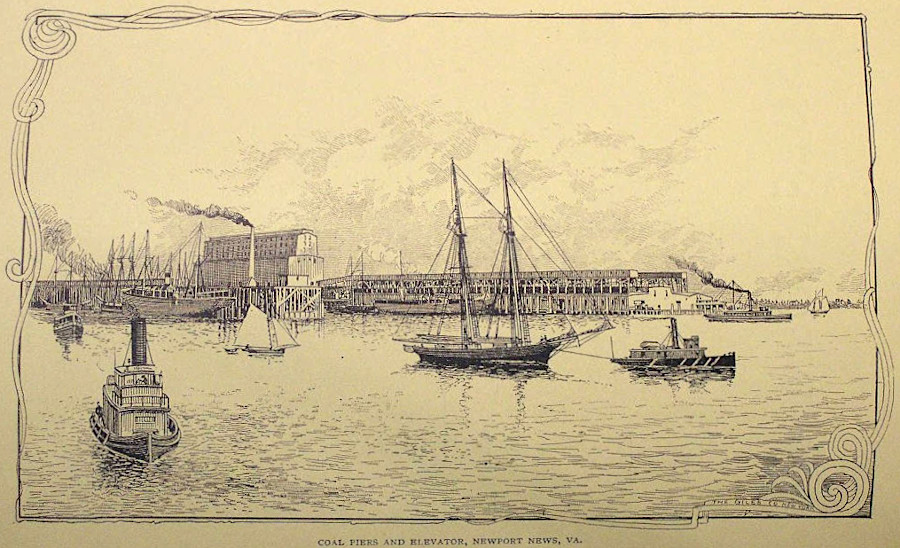
the C&O Railway ended at Newport News in 1882
Source: Newport News Public Library, Facts About Newport News
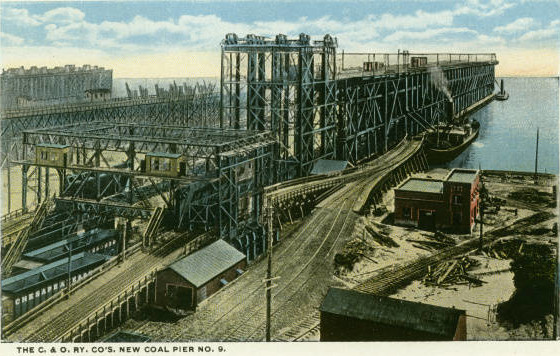
extension of the Chesapeake and Ohio Railway down the Peninsula included creation of a new coal export terminal at Newport News in 1882, and Pier 9 was constructed a decade later
Source: Newport News Public Library, C & O Railway Company's New Coal Pier
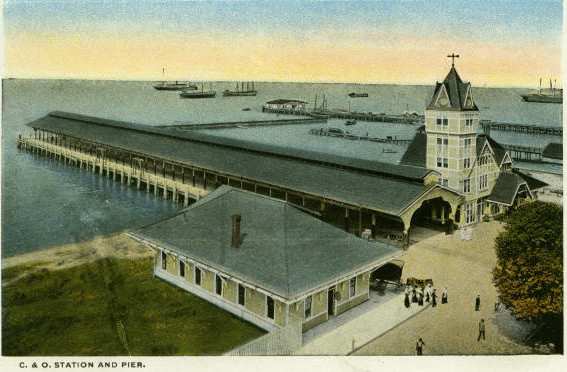
the railroad's passenger station at the pier, built in 1892, was replaced in 1940
Source: Newport News Public Library, C & O Station and Pier (1917)
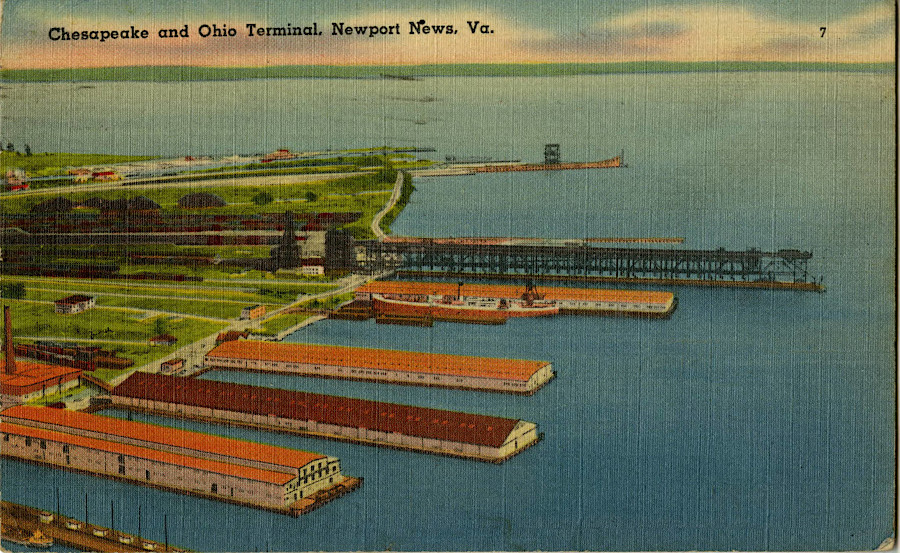
the Chesapeake and Ohio Railway piers during World War II
Source: Newport News Public Library, Chesapeake and Ohio Terminal (1944)
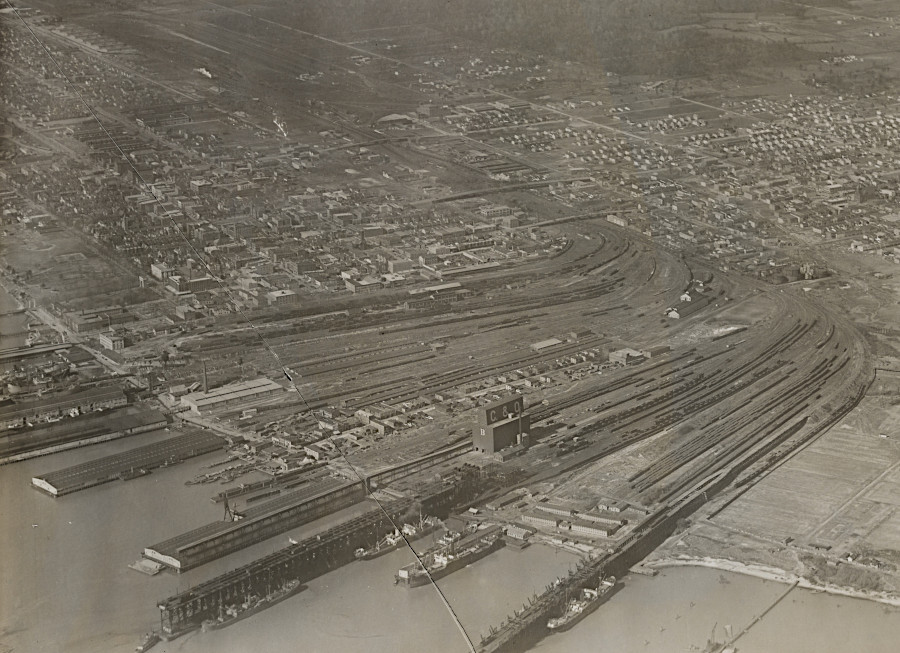
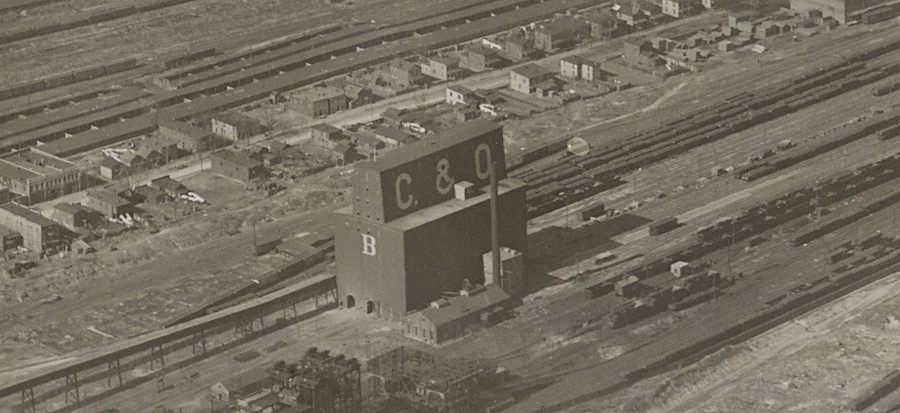
Chesapeake and Ohio Railway coal piers at Newport News (March 10, 1920)
Source: National Archives, Virginia - Newport News